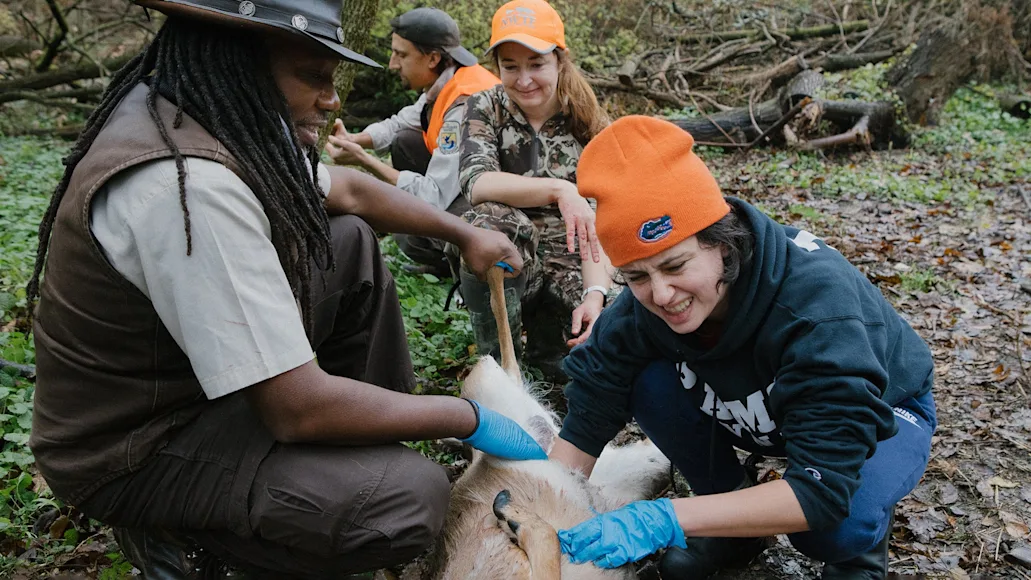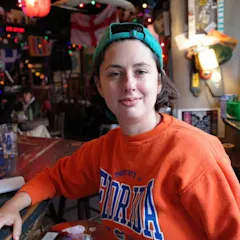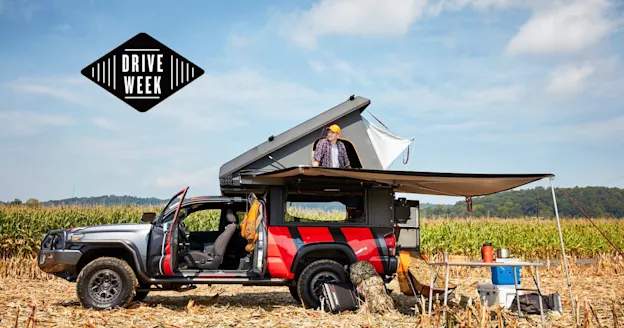MY FIRST bleary-eyed thought as I wake up in my apartment at 3:30 in the morning: If there’s a bus running right now, I don’t want to see what kind of people are on it. It’s close enough to when the bars let out in Philadelphia that any public transit will probably be full of folks coming off the tail end of a long night. There would also be those who’ve elected to wake up at the crack of dawn—the real weirdos, in my mind. Reality doesn’t set in until I take the sales tags off my thermal underwear and pick out the heaviest coat I own that I don’t mind getting blood on. By the time I call an Uber, I’ve accepted that I’m actually smack-dab in the middle of a Venn diagram of those two demographics. After all, I’m about to go hunting for the first time in the middle of one of the biggest urban areas in the country, and I spent most of last night bragging about it to anyone who’d listen at a beer-and-a-shot joint downtown.
I’ll be moving to a new city soon, and for my last week living in Philly, I’ve wanted to do something that can’t be found on any best-of list or blog. And when I found out it was possible to hunt deer within city limits, I knew what I had to do. I applied for a mentored hunt on the John Heinz National Wildlife Refuge at Tinicum through a lottery system and won, which meant that I’ve spent the last few weeks attending a basic hunter-safety course, clocking some hours behind a crossbow, and taking lessons on all the other things being a first-time hunter entails. This got off to a rough start: Spiders crawled all over my arm as I learned to set up a blind. A couple of folks—thankfully not me—found themselves covered in ticks after tracking a fake blood trail. I now assume that whatever awaits me at the refuge on the first day of my hunt could very well involve creepy-crawly things too.
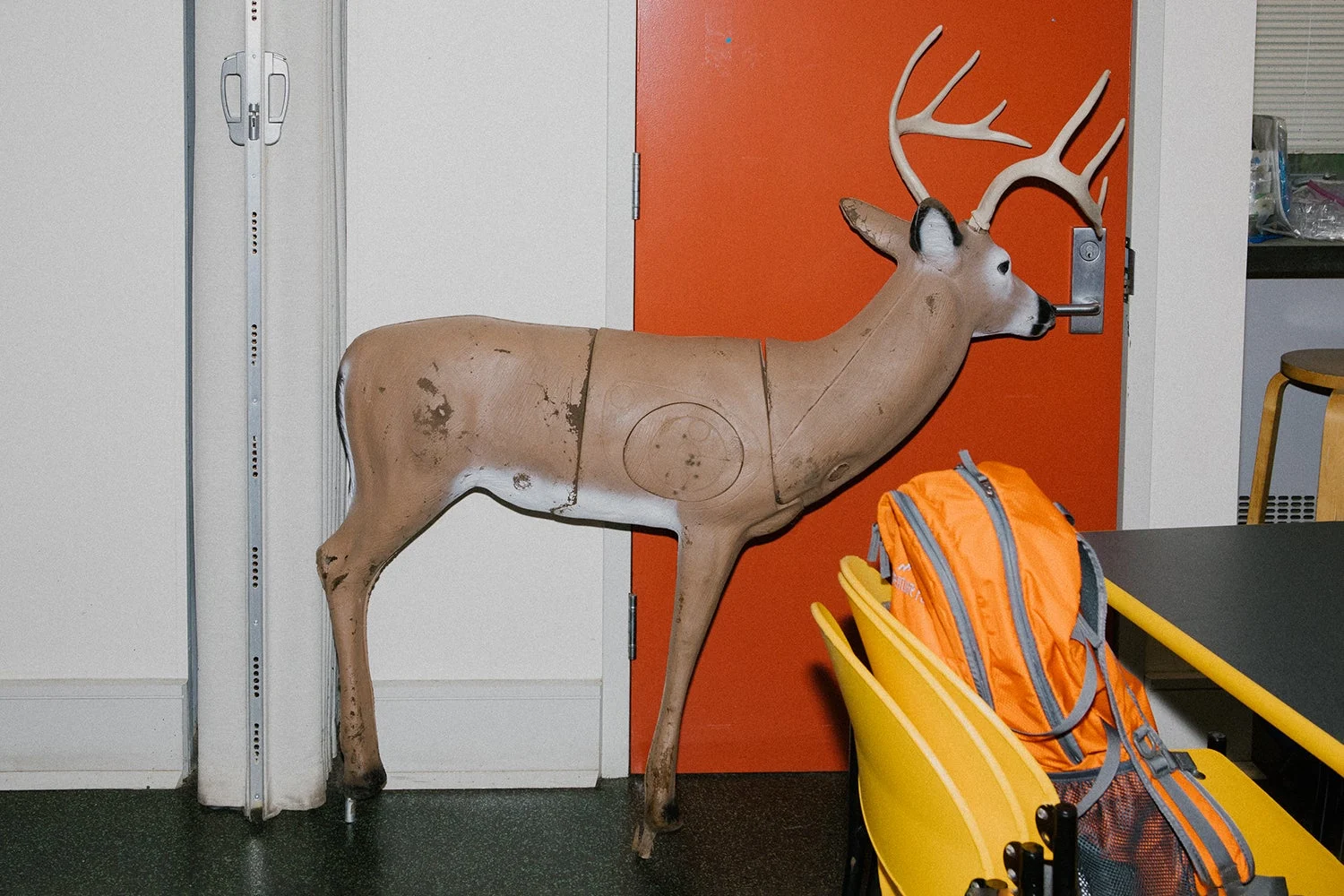
A deer target at the John Heinz Refuge used to teach shot placement to new crossbow hunters. Michelle Gustafson
I roll into the parking lot of John Heinz while it’s still pitch-black, and my Uber driver looks at me like I’m insane. But before I can head out on my hunt, I need to check in at the refuge’s main office. I recognize a lot of people from my training, including the mentor I’ll be paired with for the day. I feel lucky; Derek Stoner is an accomplished hunter and program manager with the Pennsylvania Game Commission who is both very nice and very no-nonsense. He directs me to put on an orange vest to go with the vintage Buckmasters hat I recently copped on eBay and checks off a box on a whiteboard to indicate I’m wearing the requisite amount of eye-watering neon material. Then we head out to a stand labeled “1E,” the closest of the bunch, Stoner pulling a small wagon with a crossbow in it.
I’m 5 feet tall, which means the crossbow I’m using comes up to about the bottom of my neck. Thankfully, Stoner is a normal-sized person who can get enough leverage to cock it. Then we duck into a camouflage blind and sit. And wait. And sit. Oh, and freeze. I’m originally from Florida, and the early-morning temperatures in Philadelphia in the first week of December are in the single digits.
I start to wonder if Stoner is as cold as I am, and, more generally, why someone would elect to be a mentor. It’s true that conservationists like him have a lot riding on whether first-time hunters like me enjoy their experiences. As many hunters know, the statistics have long been grim: Hunting participation peaked
in 1982, at about 17 million license-purchasing Americans. That number has been gradually declining ever since, despite the fact that the population has increased by more than 40 percent since. In 2021, the year I’m entering the picture, only about 4 percent of people in the U.S. are buying licenses—and their average age hovers around 50. In fact, baby boomers make up about one-third of the total population, and no one knows what will happen when they finally age out of the sport. Getting people like me—city-dwelling, inexperienced, female—to replace them is the best guess many people have at what will keep the sport from further decline. And part of bringing newcomers into the fold and keeping them there is making sure they have a great first hunt. Perhaps that’s why, as the light wanes approximately 12 hours into our time together, Stoner seems eager to break out all the stops. We move to a different part of the refuge, set up a decoy, and start making deer calls.

Hunting mentors, new hunters, and John Heinz Refuge employees break for lunch. Michelle Gustafson
But still, no dice. Coming into the experience, I thought I had a pretty good chance at success. After all, in 2021, Pennsylvania had
the highest number of animal-and-car collision claims of any state. Deer running on the city’s airport tarmac during the rut also frequently make the news. So by the time we head back empty-handed around 7 p.m., I start to wonder, If these conflicts are so common, why am I still not seeing any deer?
Rush Hour
A few hours after sunrise on day two, I’m in another blind with a new mentor, and I think of how I got here. I remember talking to a man named Matt Dunfee. My editor put me in touch with him while I was still deciding if I wanted to take on a mentored hunt. Dunfee told me that most folks learn from their dads, but his had been in the U.S. Forest Service, which meant he was usually unavailable during the season. He basically had to teach himself. Now Dunfee works for the Wildlife Management Institute, where a large part of his job is to help organizations and agencies figure out how to get other people to learn how to hunt on their own.
When I spoke to Dunfee over the phone, he shared the back-of-the-napkin math he did when he started his current gig: If just 30 percent of hunters brought a new person into the fold, the number of hunting permits sold would return to pre-1980 levels. There were already a number of mentored hunt programs in 2009. But they were redundant in the sense that they targeted sons and daughters of traditional hunters who were already going to learn about hunting. “We were just creating copies of ourselves,” he’d told me.
Dunfee felt the problem required a totally new approach, and he became an architect of the “theory of R3”—recruitment, retention, and reactivation. He didn’t realize quite how much he’d need to start from scratch if he was to have any chance of wooing women, people of color, and urbanites. When he held a focus group for nonhunters in 2012, only half of those who had registered bothered to show up. And among those who did, almost none were willing to kill an animal at all. Women expressed trepidation about heading into the woods with a stranger. Even the basic nomenclature around mentored hunts was in question: A minor argument broke out among some participants about who had the right to call themselves a mentor at all. People felt the term should be earned as opposed to simply given.
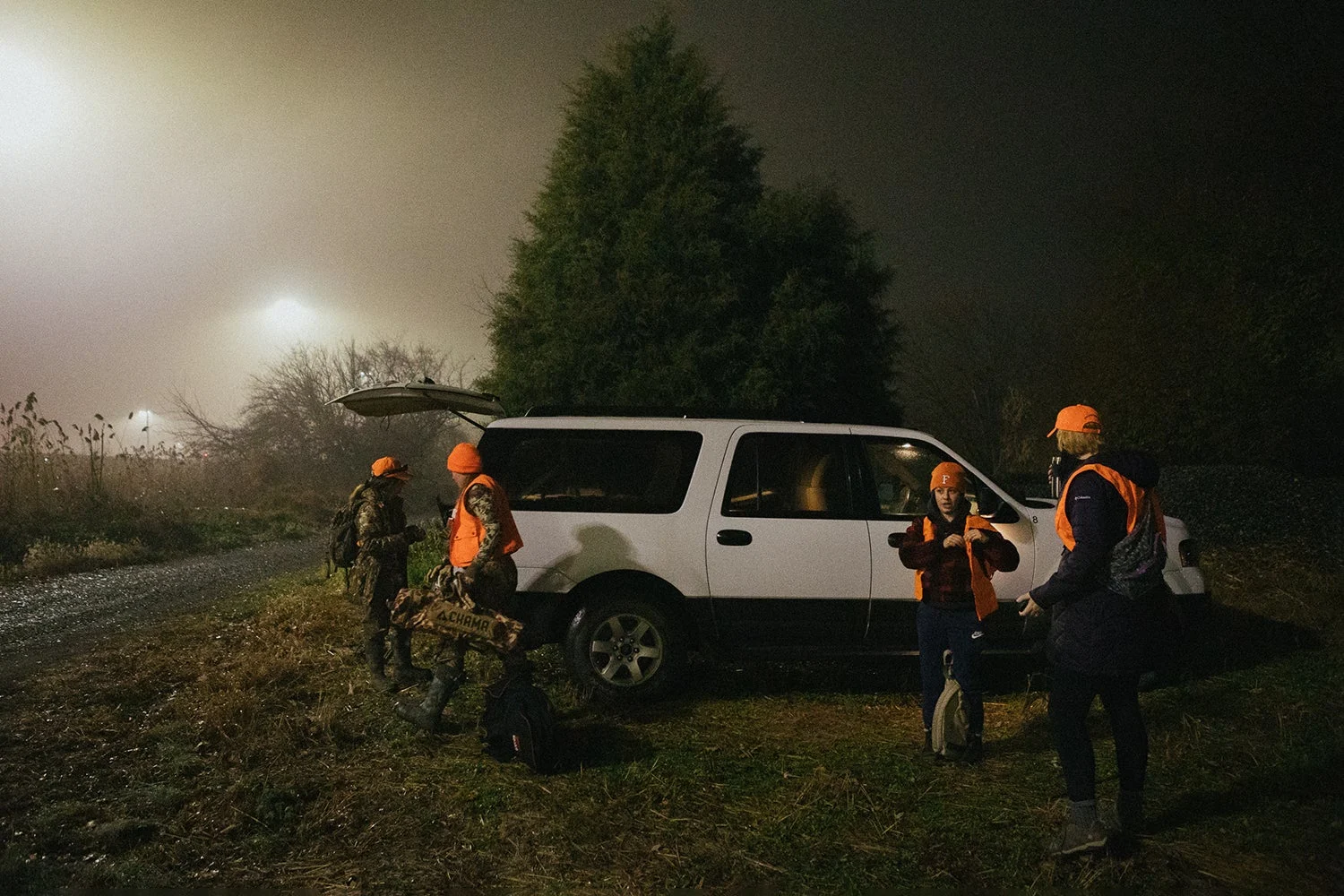
The author gears up and heads into the woods on the second morning of her hunt. Michelle Gustafson
Meanwhile, the pandemic seemed poised to solve the “recruitment” part of R3. Michigan, for instance, saw a 67 percent increase
in new hunting license buyers between 2019 and 2020. The number of women buying licenses in that state jumped by 15 percent. And most crucially, the number of “apprentice licenses” sold to first-time hunters there skyrocketed by almost 50 percent. Although the numbers are indeed promising, we still have about three to five years before we know the effect that COVID has had on hunting participation, Dunfee told me. It’s too early to say whether the people trying out hunting for the first time will return to the sport once the world reopens and they have other things to do.
Back in the blind, a commuter train barrels past my field of vision and shakes me to attention. My new mentor, Rachel Dawson from the National Fish and Wildlife Foundation, and I have been dead silent since the early morning. The 30-second intervals of sound the train provides are all the opportunity we have to adjust and breathe and generally make the tiny bits of noise that I’ve recently learned are anathema to tagging deer. The day before, I started to wonder if waking up at 3 a.m. in the freezing cold was more fun on paper. But now I’m thinking about how much more of a pain this would be if the work hadn’t already been done for me.
I run down the mental checklist: I’ve been paired up with a volunteer and directed to a blind that has already been set up, in a place where a team of experts figured I’ll have the optimal chance of spotting an animal. Come to think of it, my only job is to sit. And shiver. And occasionally be startled by the train.
In fact, I’m almost in a fugue state when the moment finally arrives and the leaves start to crunch just to my left. At first, I don’t believe it’s happening. Then I’m sure it’s a fox or a squirrel. But my heart almost leaps out of my chest when I see my first-ever doe in the flesh.
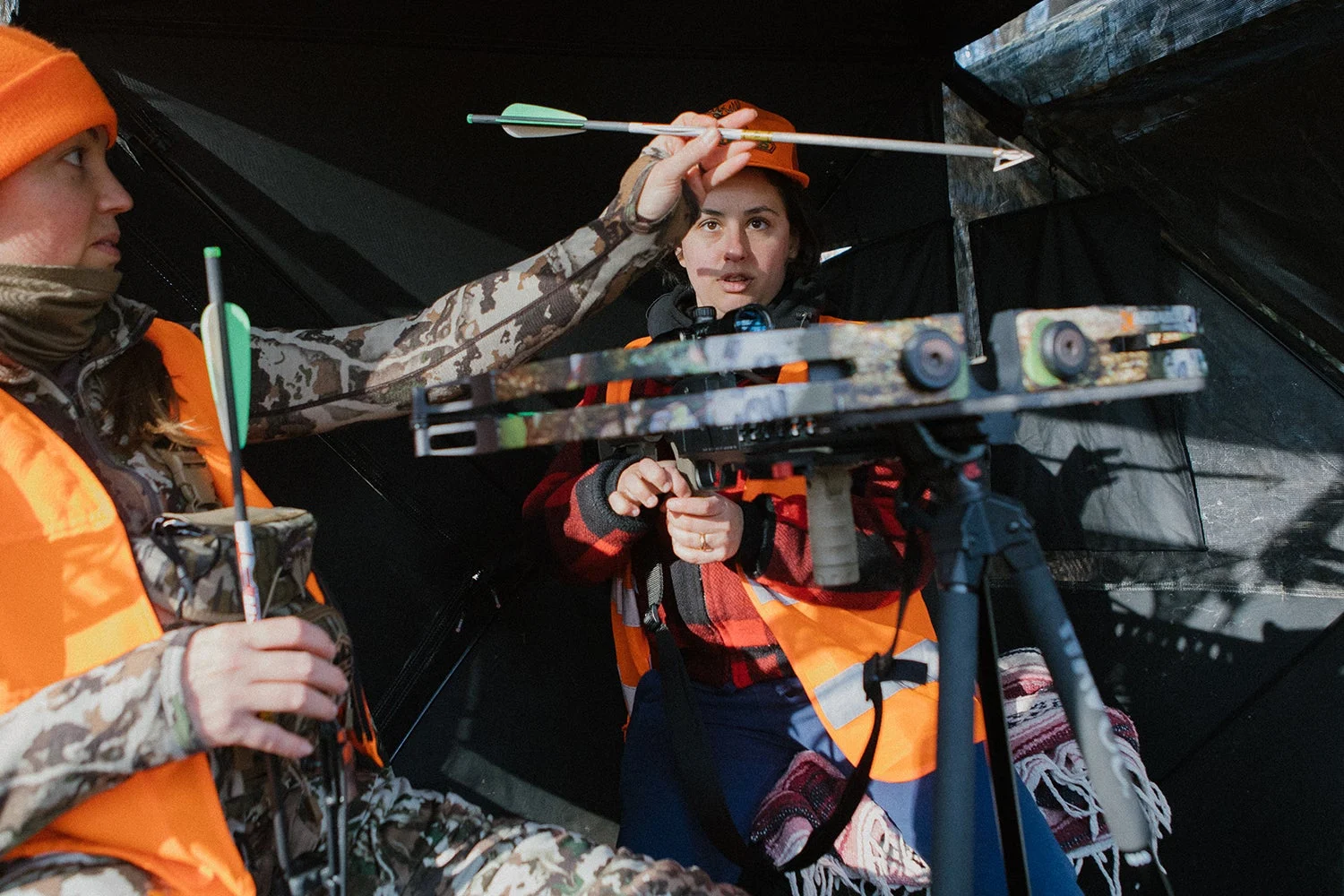
Mentor Rachel Dawson shows the author how to safely load a bolt with a broadhead in a crossbow. Michelle Gustafson
Any excitement, however, is fleeting. The photographer I’ve brought with me is also new to the world of hunting. She fiddles with her camera, and the barely perceptible clicks it makes are enough to scare the doe away. It’s excruciating whiplash—so much boredom punctuated by a second of adrenaline, followed by deep, deep shame at blowing the hunt even after so much hand-holding. But Dawson, the mentor, is here to be encouraging. Actually, that’s her main job today, more important than teaching me to handle a crossbow.
“You’ll be ready for the next one,” she tells me. I think about how boring this must be for her. She’s doing the same waiting and freezing, but when the time comes, she won’t even get to pull the trigger.
I push the thought from my mind, settle back into my folding chair, and once again stare into the distance for so long that I start imagining things that aren’t there.
Easy Mode
This is my last shot. It’s the third and final day of my hunt, and no one in my mentored cohort has managed to shoot a deer yet. But I feel obligated to deliver on everyone’s behalf. I’m in a blind with mentor Marcia Pradines Long, a refuge manager from Maryland. Through research I did prior to coming out here, I’ve learned that the John Heinz refuge used to employ sharpshooters to cull the area’s deer population so the animals wouldn’t run onto the nearby airport tarmac or bolt onto I-95 and kill an unsuspecting driver. Now it spends that money on training and kitting out would-be hunters instead. The refuge has apparently decided to gamble on new hunters taking care of the problem.
Maybe the refuge managers are as nervous as I am. I’m told that I’ve now been placed in an area that will essentially “funnel” the animal right into my line of sight. If I screw this up, there’s probably no chance for me. The money spent will have been wasted. I’ll likely never hunt again. Everyone will be put in the awkward position of having to assure me that this was a totally fine outcome, even though I’ll assume they’re lying through their teeth.
To pump myself up, I daydream of what it could look like if my day goes well. Before I came out to hunt, Garrett White, a biologist who helps run the program at Heinz, told me the legend of Binu Inbaraj—a software designer living in Delaware. He was the program’s star pupil, its No. 1 success story.
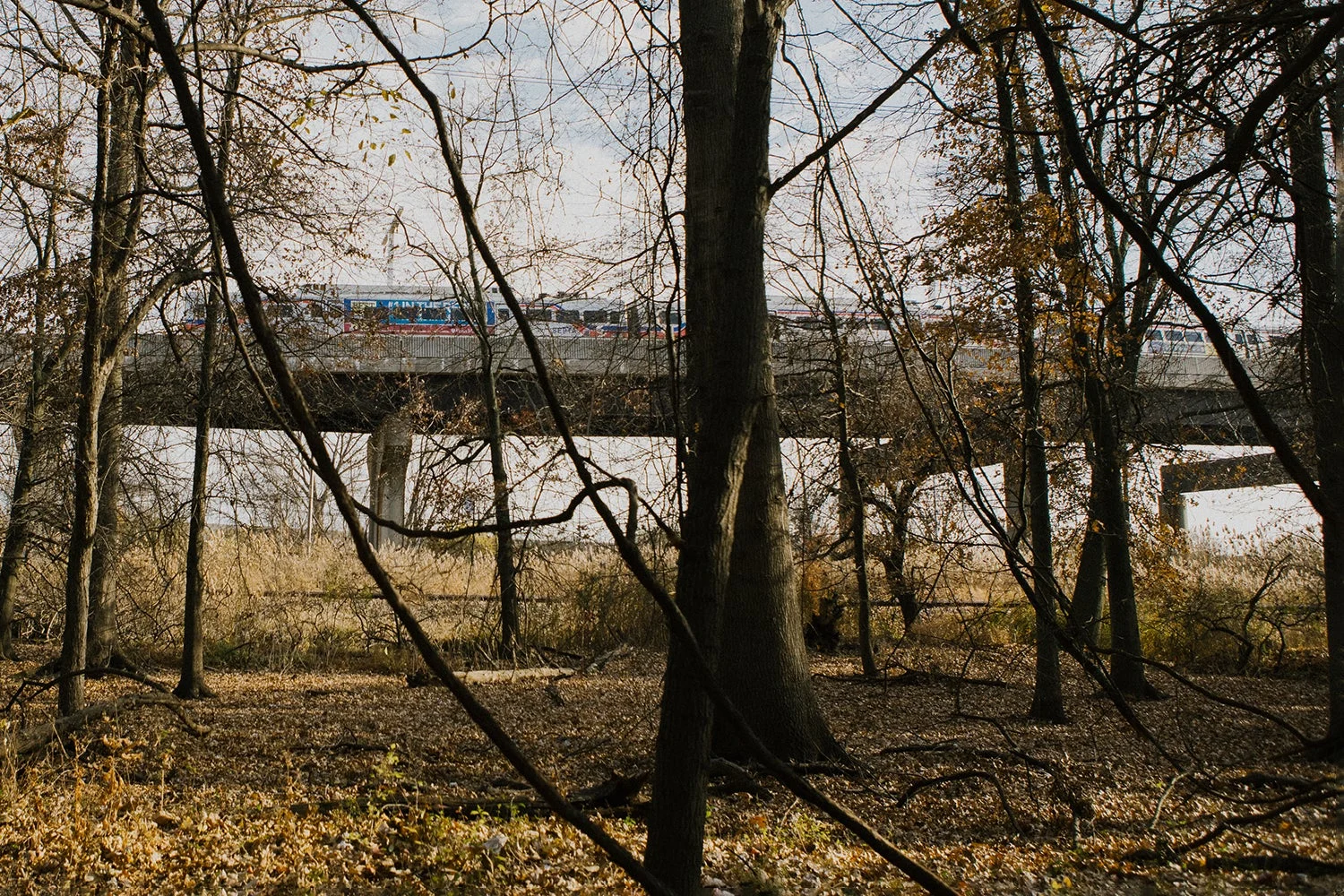
The author spots a commuter train through the window of her blind. Michelle Gustafson
As the story goes, Inbaraj—who originally hails from southern India, where hunting has been illegal since the 1970s—tried to break into the sport after moving to Delaware for work. He turned to YouTube, but he couldn’t find the information he needed. Inbaraj tried his hand at hunting pheasants and rabbits, but that didn’t work out. He went and bought his own crossbow, but never spotted an animal. He all but gave up, but then he learned about the mentored hunt program at John Heinz.
An Air Force veteran mentored Inbaraj. They shot targets together, and the veteran answered a lot of questions that simply couldn’t be answered online. In the second week of November 2020, Inbaraj was sitting in a stand when he saw an 8-point buck fighting with a 6-pointer. He took a shot from about 15 yards at the 8-pointer, but the deer ran away. He couldn’t find the arrow or any blood, and the sun was setting. Inbaraj decided to return at daybreak. He found the blood trail and texted a picture to his former mentor, who showed up and helped load the buck into an Uber. Inbaraj not only goes hunting by himself now—he’s also become a mentor.
I want what happened to Inbaraj to happen to me. But after hours of waiting in the cold, the idea of having a successful deer hunt still feels pretty far away. Even the photographer I’ve brought with me seems to have all but given up. She’s fast asleep beside me by 9 a.m.
Maybe she shouldn’t have lost hope, though. Not long after I clock her napping, a button buck appears in the window of my blind. I think about waking the photographer up, but the stakes of risking another scare-off are simply too high at this point. Instead, I grip the forearm of my mentor, Pradines Long, who is all but vibrating with excitement. After days of staring into the leaves and hallucinating animals that aren’t there, this is the confirmation I need that there is, finally, something to shoot at.
There’s an issue, though: I can’t see the deer’s head very well. There seems to be something sticking out of it, but it’s not like I can go up there with a ruler to see if the animal’s antlers are under 3 inches long, thereby making it a legal shot with my antlerless tag. I once again grip my mentor’s arm, hoping for some sort of reassurance. She looks at the deer, then turns to me with a silent look and a nod that seems to say, Take the shot whenever you’re ready. I peer into the crossbow’s sight, confident that I can, at the very least, hit the area I’ve been instructed to.
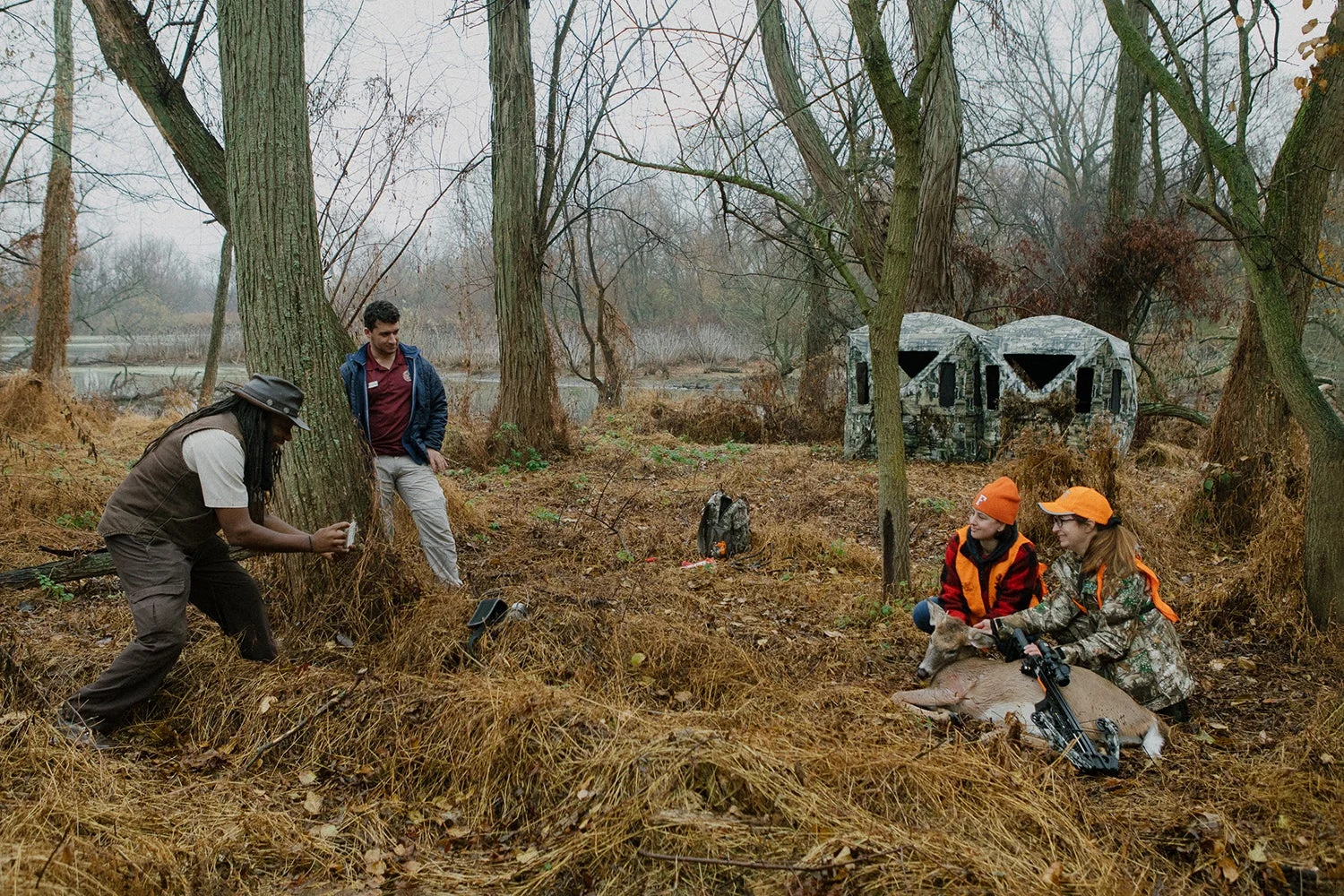
The author poses with her first deer and her hunting mentor, Pradines Long. Michelle Gustafson
I expel my breath and pull the trigger. It’s unclear to me if I even manage to keep my eyes open as 200 pounds of force course through the crossbow and release the razor-tipped arrow with a ping. I open my eyes to see the animal leaping into the air as if it’s just stepped onto a land mine. Pradines Long lets out an excited whoop. Meanwhile, the buck goes about 3 yards before collapsing onto the forest floor. Pradines Long tells me this means I must have made a double-lung-and-heart shot. I don’t tell her that I made the perfect shot while disassociating from my body and that it could have just as easily gone the other way. I assume it’s less my training and more my adrenaline—and some luck—that got the job done in the end.
Pradines Long and I don’t have to go very far to inspect our work. But by the time we’re with our deer, the warden of John Heinz and another employee are right there on an ATV. We pose for photos as the employee goes to pull my intact arrow out of a nearby tree. After the photo, I offer to drag the deer the 100 yards or so back to the ATV, but I don’t make it more than a few feet before someone stronger intervenes. Besides being 5 feet tall, I’m about 100 pounds; the job would take me hours. The warden and employee are eager to get us to the next step, that of processing the animal.
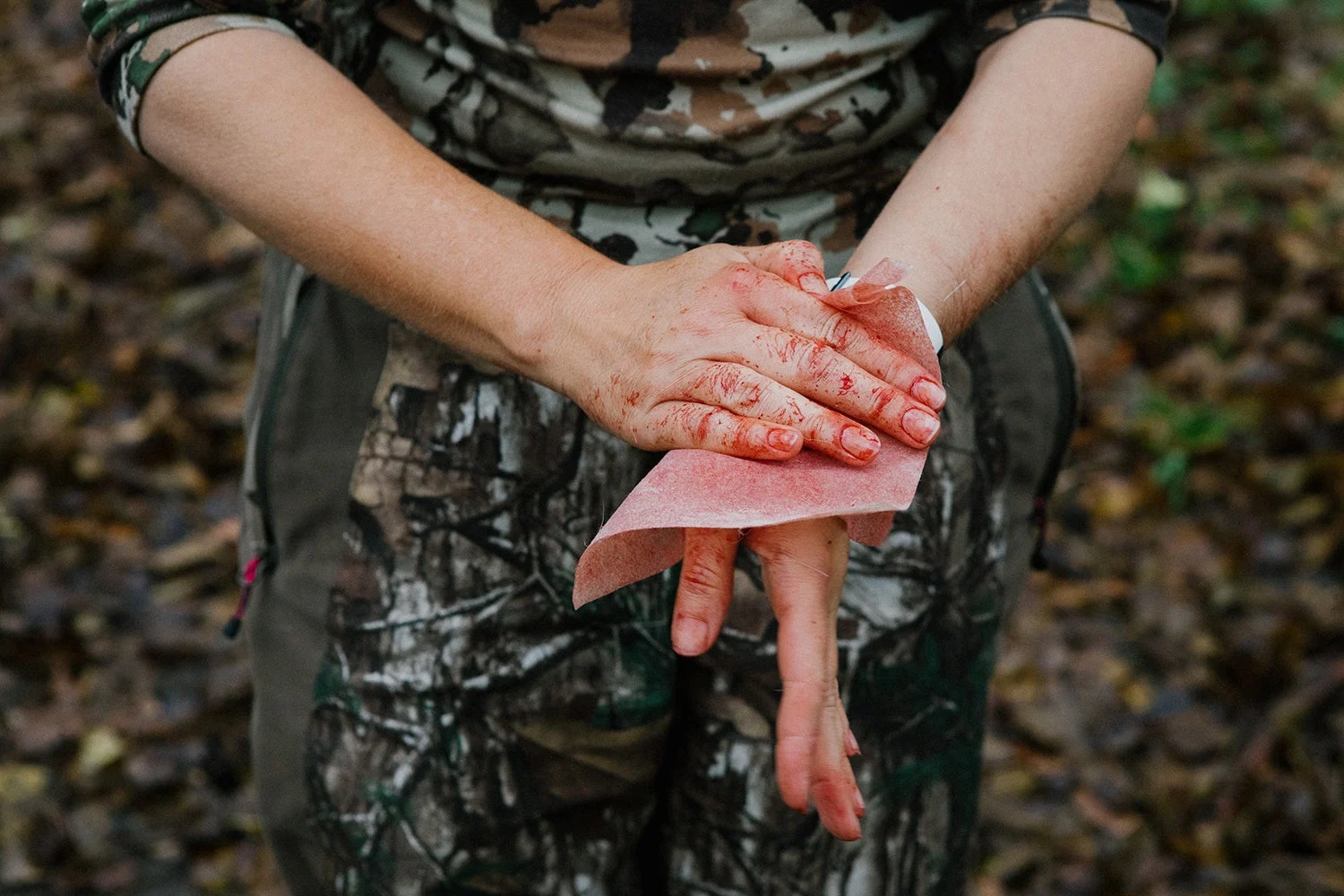
A hunting mentor cleans her hands after gutting the author’s deer. Michelle Gustafson
I’m conflicted as we head back to the refuge center. Everything about my mentored hunt felt a little like a video game from the get-go, between the pre-chosen areas and the pre-cocked crossbows. By day three and the “funnel” setup, the game had been set to easy mode. Even when we gut the deer, I’m spared the most gruesome parts. Pradines Long takes out a serrated knife and cuts through the animal’s rectum and starts pulling out the parts from there. I’m invited to take the blade and cut some of the innards out—but only after the stomach has been removed. We don’t want to risk me accidentally cutting it open and ruining the venison. When I’m instructed to reach into the deer’s chest and feel its heart while it’s still warm, it all feels a little bit like an eighth-grade science experiment. Even more than during the actual hunt, I think: How much of this could I ever do on my own?
First Impression
After shooting and gutting my deer, I—or, I should say, a team of John Heinz employees—load the animal into the truck and head to the butcher. I sit in the passenger seat as my mentor drives me to get this service performed. It’s already been paid for, which means the sum total of my contribution to the hunt will have been pulling the trigger. My only other task will be figuring out the Tetris of getting venison to fit into my tiny apartment freezer.
As we head out from the city proper, I recall that I’m not the first person to wonder how easy mentored hunt programs should be for participants. In fact, this is exactly what Dunfee, the R3 architect, has been talking to program managers about for years. He’s not one of the folks who think the pandemic will lead to the reversal of a decades-long trend. He knows there is also the matter of retention to consider. And this is where he thinks mentored hunts get it wrong.
In the ’50s and ’60s, about twice as many people went small-game hunting as went big-game hunting. Now nearly the opposite is true, due in part to what’s portrayed in hunting media. “An expectation has developed in millennials and Gen Z that you start off with a big-game hunt,” he told me. To cater to those expectations, most mentored hunt programs tend to focus on so-called charismatic megafauna, like deer.
And while I’ve found that going after deer is fun and exciting—at least for the few minutes that aren’t excruciatingly boring—I get Dunfee’s criticism. It’s been made abundantly clear to me that it’s difficult to hunt deer on your own. A more useful thing to learn might be, say, hunting rabbits with a .22. (To be fair, that’s not an option at John Heinz—discharging a firearm is illegal within city limits. And having people go after small game with a crossbow would just set them up for extreme frustration.)
But on our drive, I learn that deer hunting can also go terribly wrong for first-timers. Apparently someone else in my cohort—a kid who came out with his big sister—saw a deer earlier that day, but took a risky shot and wounded the animal. Now, they’re in for a long day of tracking a suffering deer through the woods. It’s upsetting news, but I’m selfishly glad that at least I’m not the one who has to deal with the guilt of something like that. Despite my reservations about the ease of the program, and some minor shock about having taken a life, I can’t help but feel good about myself. Although I probably wouldn’t be keen to hunt deer again, I’ve braved the cold and met my goal of doing something outside of my comfort zone. I’ve also gotten to see a part of Philly I’d never have seen otherwise. It was a hell of a goodbye.
By evening, I’m heading home to an apartment full of boxes. I’m leaving town tomorrow, and there’s a ton to do, but I’ve taken Dunfee’s advice to heart, and I’m already making plans to hunt something a little smaller next time. I’m texting with my editor and looking up what’s in season next when an unknown number flashes on my caller ID. It’s Stoner, my first mentor, who heard about what happened earlier that day. He asks me to repeat the story, and while I think that it’s short, I later see that we’ve spoken for more than 15 minutes. Then it strikes me that I’ve actually learned a skill that I’ll definitely be able to use again: How to tell a hunting story.
_Read more F&S+
stories._

